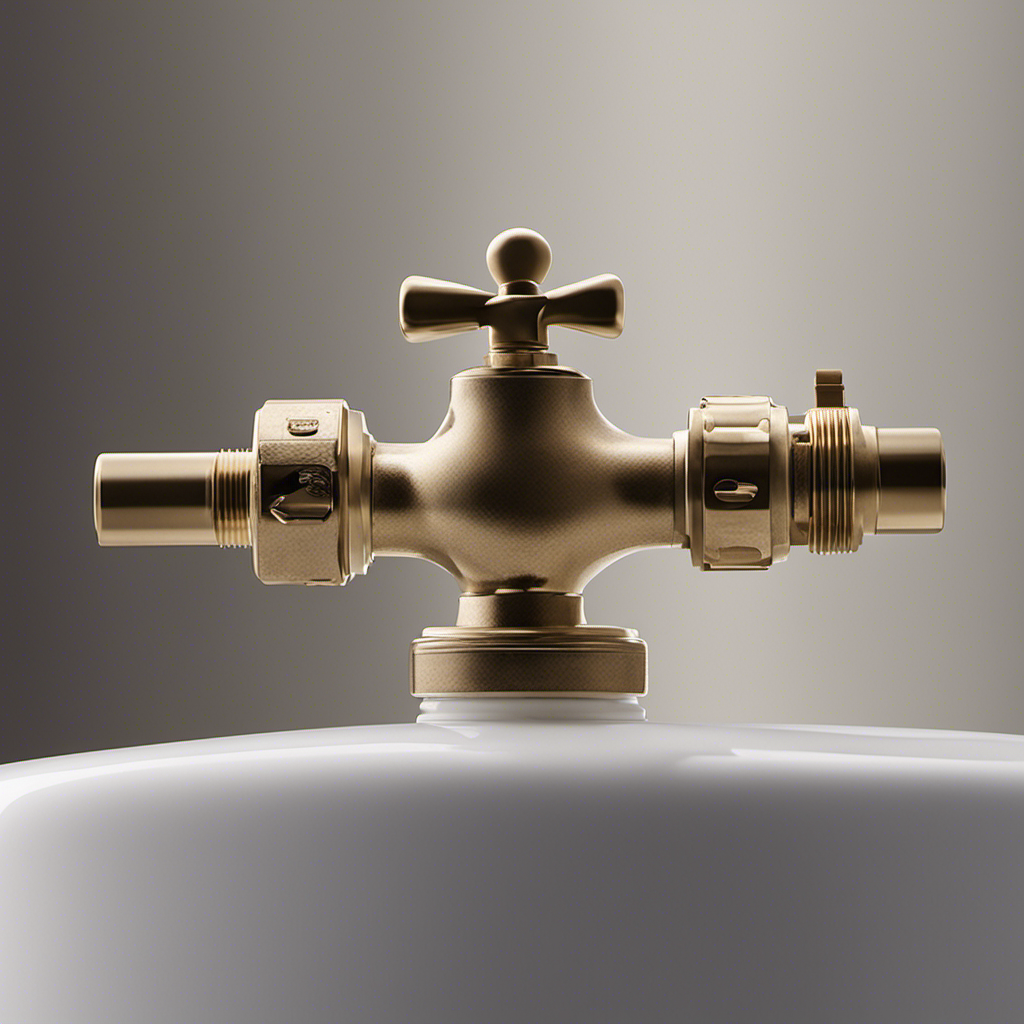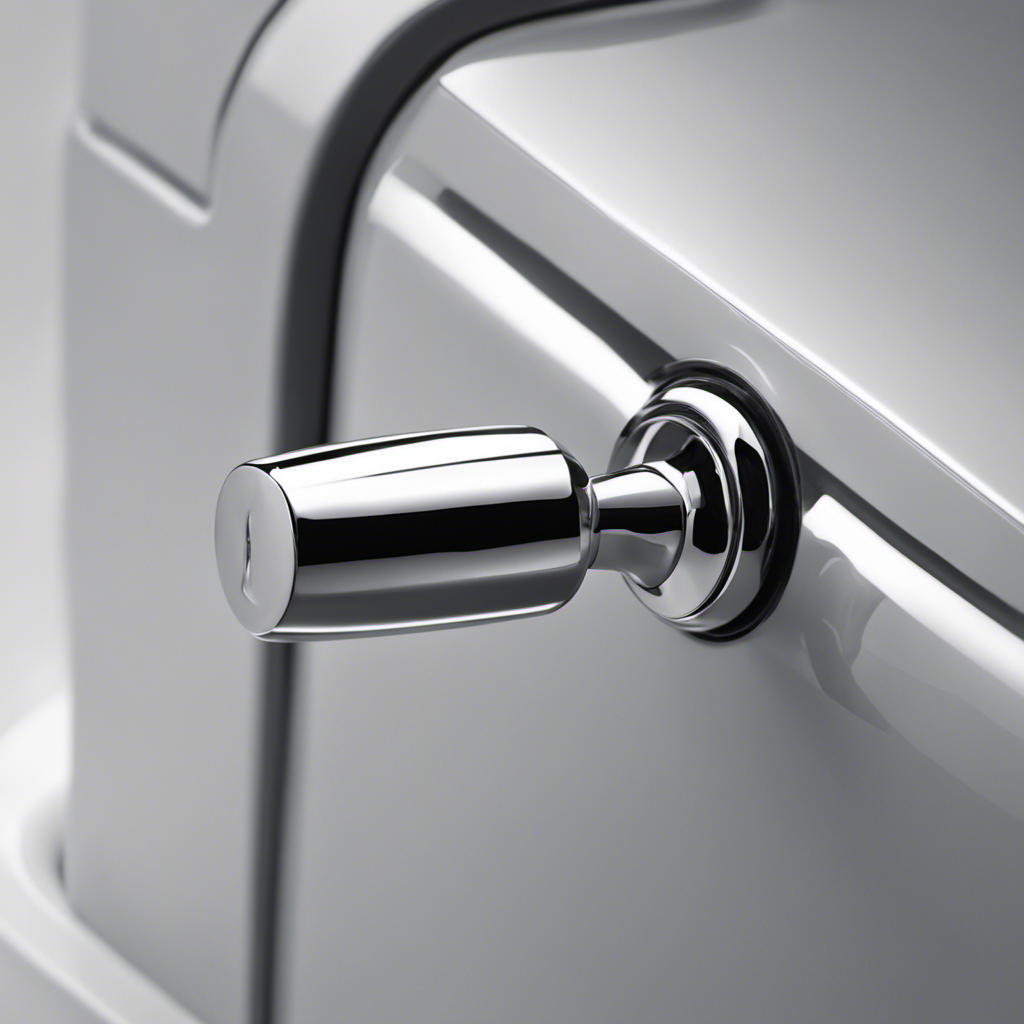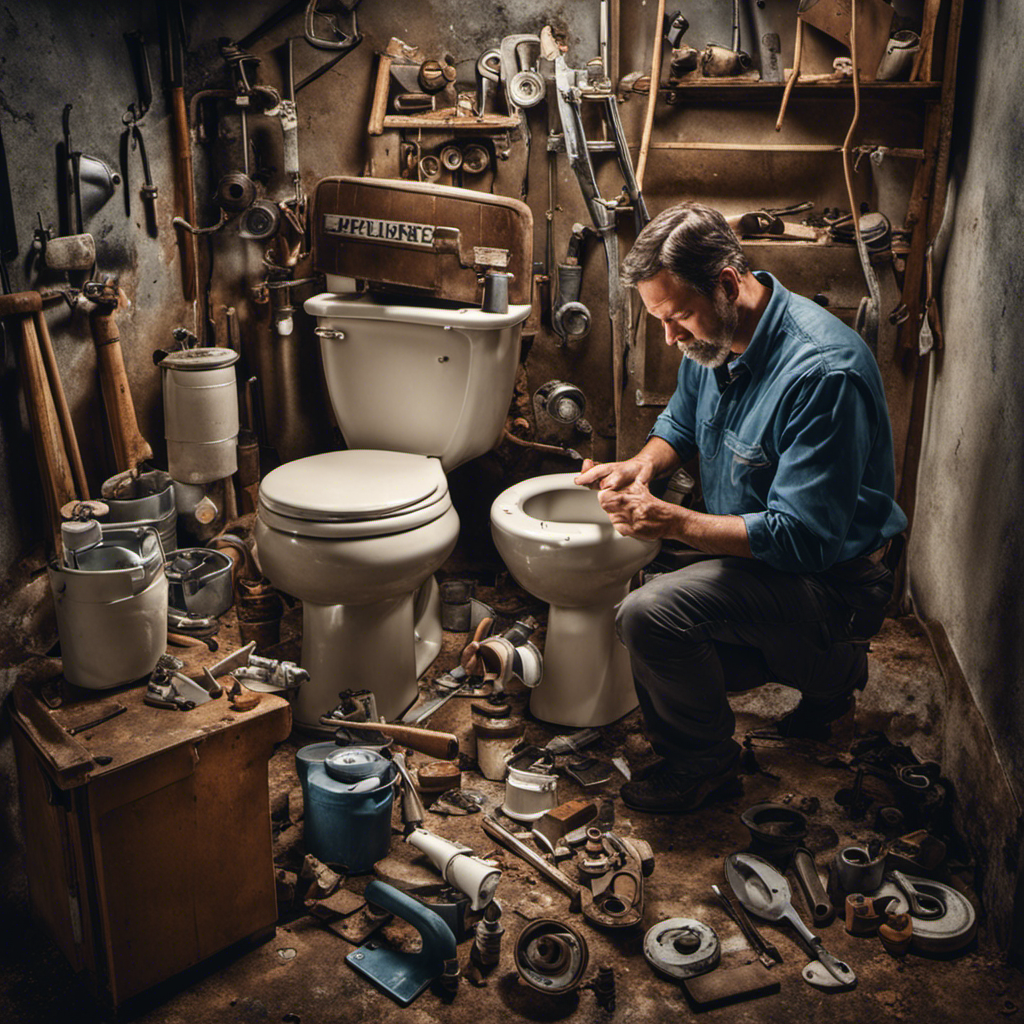Are you tired of dealing with that leaky toilet water supply valve? Don’t let it dampen your day any longer. It’s time to take control and replace it yourself.
In this step-by-step guide, we will show you how to tackle this plumbing task with confidence. With just a few tools and some determination, you’ll be able to successfully swap out that faulty valve and restore peace to your bathroom oasis.
So, roll up your sleeves and let’s get started!
Key Takeaways
- Shut off the water supply to prevent water damage and locate the shut-off valve in a clockwise motion.
- Use the necessary tools and materials to remove and install a new toilet water supply valve, being careful not to damage surrounding pipes or fittings.
- Regularly inspect and clean the water supply valve to prevent clogs and leaks and ensure a smooth and efficient water flow.
- Troubleshoot common issues such as water leakage, low water pressure, and a valve that doesn’t shut off completely by checking for loose connections, worn-out washers, clogged pipes, and faulty valves.
Tools and Materials Needed
You’ll need a few tools and materials to replace the toilet water supply valve. First, gather a pair of adjustable pliers, a pipe wrench, Teflon tape, a bucket, and a new toilet water supply valve. These items will help you successfully complete the task.
Troubleshooting leaks is an important aspect of this process. To ensure a leak-free installation, make sure to inspect the existing valve for any signs of leakage. If there are leaks, you may need to replace the entire valve assembly.
Additionally, adjusting water pressure may be necessary to prevent future leaks. This can be done by adjusting the water pressure regulator, typically located near the main water supply valve.
Shutting Off the Water Supply
To stop the flow of water, turn the shut-off valve clockwise until it is fully closed. Shutting off the water supply is an important step when replacing a toilet water supply valve.
Here are some key points to keep in mind:
-
Prevent water damage: Shutting off the water prevents any potential leaks or floods while working on the valve.
-
Locating the shut-off valve: The shut-off valve is usually located near the toilet, either on the wall or on the floor.
-
Clockwise motion: Turning the valve clockwise will close it, stopping the water flow.
-
Fully closed: Ensure the valve is fully closed to completely stop the water supply.
-
Testing the shut-off: After closing the valve, check if the water flow has stopped by flushing the toilet.
Removing the Old Water Supply Valve
To remove the old water supply valve, start by loosening the connection using a wrench.
Before beginning, it’s important to turn off the main water supply to your house.
Once that is done, locate the valve near the toilet and use the wrench to loosen the nut connecting the valve to the water line.
If the valve is rusted and difficult to loosen, you can try using penetrating oil to help loosen it.
Be careful not to damage the surrounding pipes or fittings while removing the valve.
Once the connection is loosened, gently twist and pull the valve off the water line.
Now that the old valve is removed, you can move on to choosing the right replacement valve for your toilet.
Installing the New Water Supply Valve
When it comes to installing a new water supply valve, there are a few key steps to follow.
First, you’ll need to gather the necessary tools and materials, such as an adjustable wrench, Teflon tape, and a new valve.
Once you have everything you need, you can begin the installation process.
However, it’s important to be aware of common issues that can arise during installation, such as leaks or difficulty turning the valve.
Troubleshooting these problems will ensure a successful installation.
Valve Installation Steps
First, you’ll need to shut off the water supply to the toilet before proceeding with the valve installation. This is an essential step to ensure that no water leaks out during the process. Once the water supply is turned off, follow these steps for a successful valve installation:
- Remove the old valve by unscrewing it from the water supply line.
- Clean the area around the pipe where the new valve will be installed.
- Apply plumber’s tape to the threads of the new valve to prevent leaks.
- Screw the new valve onto the water supply line, making sure it is tight but not over-tightened.
- Turn the water supply back on and check for any leaks.
Valve maintenance is crucial to ensure the proper functioning of your toilet. There are different types of valves, including ball valves and gate valves. Understanding the type of valve in your toilet can help you perform maintenance tasks effectively.
Regularly inspecting and cleaning the valve can prevent clogs and leaks, ensuring a smooth and efficient water flow.
Required Tools and Materials
You’ll need a few tools and materials for the valve installation. These include an adjustable wrench, plumber’s tape, and a new valve. These materials are essential for a successful replacement and will ensure that your toilet water supply remains functional.
The adjustable wrench will help you loosen and tighten the necessary connections. It is an important tool to have on hand during the installation process.
Plumber’s tape is another essential material. It provides a secure seal and helps prevent leaks. Make sure to apply it properly for a tight and reliable connection.
In addition to the wrench and tape, a new valve is required to replace the old, faulty one. This is the main component that needs to be replaced in order to restore functionality to your toilet’s water supply.
Without these materials, the valve installation process will be challenging and may not yield the desired results. It is important to have all the necessary tools and materials on hand before starting the installation.
Troubleshooting Common Issues
One common issue that may arise is a leak in the toilet’s water connection. This can lead to water damage, higher water bills, and an inefficient flushing system.
To troubleshoot this issue, you can try the following methods:
- Check the water supply line for any visible leaks or cracks.
- Tighten the water supply connection to ensure it is properly sealed.
- Replace the water supply line if it is old or damaged.
- Inspect the toilet tank for any cracks or damage that may be causing the leak.
- If the issue persists, the problem may be with the toilet’s water supply valve. To fix a stuck valve, turn off the water supply and use pliers to loosen and remove the valve cap. Clean any debris or sediment that may be causing the valve to stick, then reassemble and test.
Connecting the Water Supply Line
To connect the water supply line, start by turning off the main water valve. This is an important step to ensure that no water flows while you work on the installation.
Once the main water valve is closed, locate the existing water supply valve near the toilet. If the valve is old or faulty, it may need to be replaced. However, if it is still in good condition, you can proceed with connecting the water supply line to it.
Attach one end of the supply line to the water supply valve and tighten it securely. Then, attach the other end to the bottom of the toilet tank, making sure it is properly aligned.
Once the connection is secure, you can move on to testing for leaks to ensure everything is functioning properly.
Testing for Leaks
Now that everything is securely connected, it’s time to check for any leaks and make sure there are no problems with the installation. Here are some important steps to follow when testing for leaks and performing water supply valve maintenance:
-
Inspect the valve body: Carefully examine the water supply valve body for any visible cracks or signs of damage. Cracks can lead to leaks and should be addressed immediately.
-
Turn on the water supply: Slowly turn on the water supply valve to allow water to flow into the toilet tank. Keep an eye out for any water leakage around the valve or the connection points.
-
Check for drips: Look for any drips or small leaks around the valve stem and the water supply line. Even a small drip can lead to water damage over time.
-
Tighten connections: If you notice any loose connections, use a wrench to tighten them. Loose connections can cause leaks and compromise the integrity of the water supply.
-
Listen for unusual sounds: Pay attention to any hissing or gushing sounds coming from the valve. Unusual sounds could indicate a problem with the valve and may require further inspection.
Troubleshooting Common Issues
If you’re experiencing a leaking water supply valve or low water pressure, don’t worry. These are common issues that can be easily resolved. Leaking water supply valves are often caused by loose connections or worn-out washers. You can fix this by tightening the connections or replacing the washer.
Low water pressure can be a result of various factors, such as clogged pipes or a malfunctioning pressure regulator. To resolve this issue, you can clean the pipes or adjust the regulator.
If your valve is not shutting off completely, it could be due to a faulty valve or a buildup of debris. In this case, you can try replacing the valve or cleaning it to ensure proper functionality.
Leaking Water Supply Valve
Check if your water supply valve is leaking by examining the area around the valve for any signs of water. If you notice water pooling or dripping, it’s likely that your valve is leaking and needs to be fixed promptly.
Here are some important steps to follow when repairing a leaking water supply valve:
- Turn off the water supply: Before you start any repairs, make sure to shut off the water supply to the valve to prevent any further leakage.
- Tighten the valve: Check if the valve is loose and try tightening it with a wrench. Sometimes, a loose valve can cause leaks.
- Replace the valve stem: If tightening the valve doesn’t solve the issue, you may need to replace the valve stem. This involves removing the old stem and installing a new one.
- Use Teflon tape: To ensure a watertight seal, wrap Teflon tape around the threads of the valve before reattaching it.
- Test for leaks: After completing the repairs, turn on the water supply and carefully check for any signs of leakage.
Low Water Pressure
You may be experiencing low water pressure if you notice a weak flow from your faucets or showerhead. This can be frustrating, but luckily there are some steps you can take to increase water pressure and improve your water flow. One common cause of low water pressure is a clogged toilet. If your toilet is not flushing properly or takes a long time to fill up, it may be due to a clogged water supply valve. To fix this, you can try turning off the water supply valve, disconnecting the hose, and cleaning out any debris or sediment that may be causing the blockage. This simple fix can help restore your water pressure and ensure your toilet is working properly.
| Step | Instructions |
|---|---|
| 1 | Turn off the water supply valve to the toilet. |
| 2 | Disconnect the hose from the water supply valve. |
| 3 | Check for any debris or sediment in the valve. |
| 4 | Clean out the valve using a brush or cloth. |
| 5 | Reconnect the hose and turn on the water supply valve. |
Valve Not Shutting off
The valve isn’t shutting off properly, which can cause issues with your water pressure and flow. If you’re experiencing this problem, don’t worry, there are steps you can take to fix it. Here’s what you need to know:
-
Check for leaks: Inspect the valve and surrounding pipes for any signs of leaks or drips. Fixing leaks is crucial to ensure proper functioning of the valve.
-
Turn off the water supply: Before replacing the valve, make sure to shut off the water supply to prevent any accidents or further damage.
-
Gather the necessary tools: You’ll need an adjustable wrench, a bucket to catch any residual water, and a new valve for replacement.
-
Remove the old valve: Use the adjustable wrench to loosen and disconnect the old valve from the water supply line.
-
Install the new valve: Attach the new valve to the water supply line and tighten it securely using the wrench.
Conclusion
In conclusion, replacing a toilet water supply valve is a relatively simple task that can be accomplished with just a few tools and materials. By following the step-by-step instructions provided in this article, you can easily shut off the water supply, remove the old valve, install the new one, and connect the water supply line.
Once everything is in place, don’t forget to test for leaks and troubleshoot any common issues that may arise. With a little bit of know-how and some elbow grease, you’ll have your toilet running smoothly in no time!










